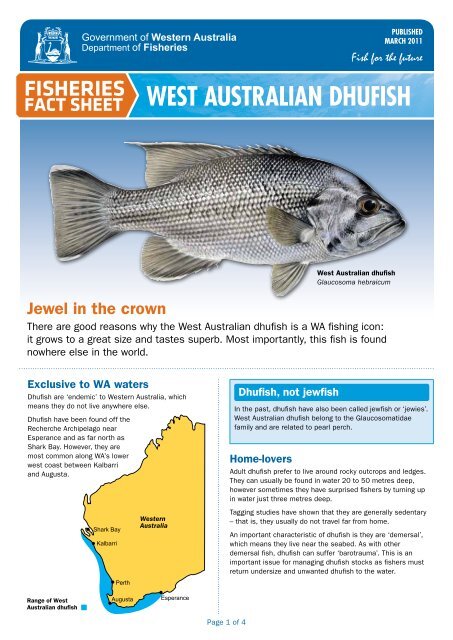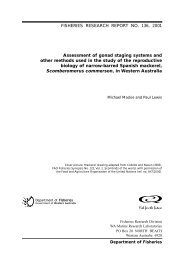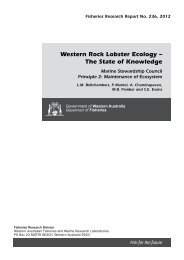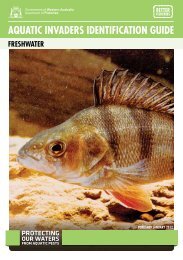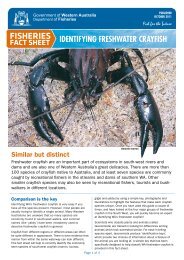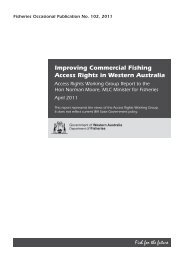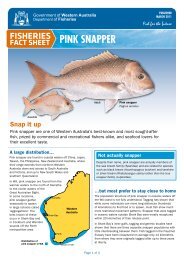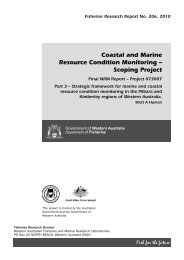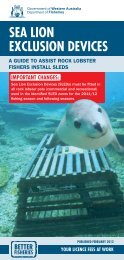West Australian Dhufish Fact Sheet - Department of Fisheries
West Australian Dhufish Fact Sheet - Department of Fisheries
West Australian Dhufish Fact Sheet - Department of Fisheries
You also want an ePaper? Increase the reach of your titles
YUMPU automatically turns print PDFs into web optimized ePapers that Google loves.
FISHERIES<br />
FACT SHEET<br />
Exclusive to WA waters<br />
<strong>Dhufish</strong> are ‘endemic’ to <strong>West</strong>ern Australia, which<br />
means they do not live anywhere else.<br />
<strong>Dhufish</strong> have been found <strong>of</strong>f the<br />
Recherche Archipelago near<br />
Esperance and as far north as<br />
Shark Bay. However, they are<br />
most common along WA’s lower<br />
west coast between Kalbarri<br />
and Augusta.<br />
Shark Bay<br />
Kalbarri<br />
Perth<br />
Augusta<br />
Esperance<br />
Page 1 <strong>of</strong> 4<br />
<strong>West</strong> <strong>Australian</strong> dhufish<br />
Glaucosoma hebraicum<br />
Jewel in the crown<br />
There are good reasons why the <strong>West</strong> <strong>Australian</strong> dhufish is a WA fishing icon:<br />
it grows to a great size and tastes superb. Most importantly, this fish is found<br />
nowhere else in the world.<br />
Range <strong>of</strong> <strong>West</strong><br />
<strong>Australian</strong> dhufish<br />
<strong>West</strong>ern<br />
Australia<br />
<strong>Dhufish</strong>, not jewfish<br />
PuBlished<br />
MArCh 2011<br />
<strong>West</strong> AustrAliAn dhufish<br />
In the past, dhufish have also been called jewfish or ‘jewies’.<br />
<strong>West</strong> <strong>Australian</strong> dhufish belong to the Glaucosomatidae<br />
family and are related to pearl perch.<br />
Home-lovers<br />
Adult dhufish prefer to live around rocky outcrops and ledges.<br />
They can usually be found in water 20 to 50 metres deep,<br />
however sometimes they have surprised fishers by turning up<br />
in water just three metres deep.<br />
Tagging studies have shown that they are generally sedentary<br />
– that is, they usually do not travel far from home.<br />
An important characteristic <strong>of</strong> dhufish is they are ‘demersal’,<br />
which means they live near the seabed. As with other<br />
demersal fish, dhufish can suffer ‘barotrauma’. This is an<br />
important issue for managing dhufish stocks as fishers must<br />
return undersize and unwanted dhufish to the water.
Barotrauma<br />
You have probably heard <strong>of</strong> SCUBA divers getting ‘the<br />
bends’ because they ascended to the surface too quickly<br />
after a deep dive. Some demersal fish experience similar<br />
problems when they are caught in deep water and pulled<br />
rapidly to the surface on a fishing line. This condition,<br />
which results from gases expanding in the fish’s body, is<br />
called barotrauma.<br />
The most obvious signs <strong>of</strong> barotrauma in a fish are a<br />
bloated stomach, bulging eyes and the stomach pushed<br />
out through the mouth or gills. A fish with these symptoms<br />
may not survive when put back and may simply float on the<br />
sea surface. However, its chances <strong>of</strong> recovering may be<br />
improved if a fisher uses a release weight.<br />
A release weight consists <strong>of</strong> a barbless hook with a weight<br />
attached that is inserted through the fish’s lip. The fish is<br />
then lowered into the water and when it reaches the depth<br />
from which it came, it can be released by a gentle tug on<br />
the line. Once back in deep water, gases in the fish swiftly<br />
recompress, saving it from further injury.<br />
Page 2 <strong>of</strong> 4<br />
Predators and prey<br />
‘Dhuies’ have big eyes and cavernous mouths, with which<br />
they prey on other fish, crustaceans and molluscs such as<br />
squid and octopus. As larvae and juveniles they may be prey<br />
to a wide range <strong>of</strong> other sea creatures.<br />
Adult dhufish have a distinctive vertical dark line called a<br />
chevron running through their eye that fades once they die<br />
and which is also fainter on females. Juvenile dhuies have<br />
black stripes along their body.<br />
A three-month-old juvenile dhufish measuring just over three<br />
centimetres. Photo: Julia Shand, University <strong>of</strong> WA<br />
At the larval stage, dhufish have huge eyes relative to<br />
their head size. This makes them very well adapted to<br />
seeing in low levels <strong>of</strong> light.<br />
Summer spawning<br />
During spawning, eggs and sperm are released into the<br />
water and fertilisation occurs externally. At these times,<br />
dhufish may gather in groups called ‘aggregations’. This<br />
generally occurs between November and April with the peak<br />
period being between December and March, when water<br />
temperatures are elevated.<br />
While there is much about dhufish behaviour that is yet to<br />
be fully understood, it appears that this species displays<br />
complex social behaviour during spawning with larger<br />
individuals dominating and achieving greater spawning<br />
success. Males and females probably spawn in pairs.<br />
Gender difference<br />
Adult male dhufish are <strong>of</strong>ten bigger than female dhufish.<br />
Another easy way to tell the difference between male and<br />
female dhufish is the presence <strong>of</strong> an elongated filament on<br />
the dorsal fins <strong>of</strong> males.<br />
Filament<br />
Photo: Garry Lilley An adult male dhufish. Note the long filament on its dorsal fin.
The importance <strong>of</strong> big dhuies<br />
<strong>Dhufish</strong> can live for more than 40 years, reach more than a<br />
metre in length and weigh more than 25 kilos. As with many<br />
bottom-dwelling fish, they are relatively slow-growing.<br />
They also grow most quickly when they are young. Their growth<br />
slows down considerably after about 12 years, and they<br />
reach close to their maximum size at about 20 years. Like all<br />
animals, individual dhufish may be larger or smaller than their<br />
peers at the same age.<br />
Previous research showed that dhufish start to reach sexual<br />
maturity at three to four years old, or when they were 30 to 35<br />
centimetres long. Recent research indicates that even though<br />
dhufish are reproductive at this time, females produce few<br />
eggs and do not spawn every month <strong>of</strong> the spawning season.<br />
It appears that dhufish only reach their full reproductive<br />
potential as they become larger and thus older.<br />
Older and larger female dhufish spawn more eggs, more <strong>of</strong>ten<br />
and for a longer period – and therefore produce more eggs<br />
per spawning season – than younger females. This means big<br />
female dhufish are very important for the overall health <strong>of</strong> a<br />
dhufish population.<br />
Percentage <strong>of</strong> spawning females<br />
80<br />
60<br />
40<br />
20<br />
0<br />
Small (up to 50cm long)<br />
Medium (50 to 70cm long)<br />
Large (70cm or longer)<br />
Nov Dec Jan Feb Mar Apr May June<br />
Month<br />
During each month <strong>of</strong> the spawning season, fewer small<br />
female dhufish spawn than medium and large-sized females.<br />
How old is this dhufish?<br />
Working out the age <strong>of</strong> sampled dhufish helps researchers<br />
understand the ‘age structure’ <strong>of</strong> a dhufish population, in<br />
other words, how many fish there are <strong>of</strong> different ages. This<br />
in turn tells them whether fishing is reliant on a particularly<br />
successful year class <strong>of</strong> fish – that is, fish spawned during a<br />
certain year – or whether recruitment has also been good in<br />
other years.<br />
The ear bones <strong>of</strong> fish, called otoliths, contain a detailed<br />
record <strong>of</strong> their age. Each year, as a fish grows, tiny bands <strong>of</strong><br />
calcified material are laid down in the bone, similar to growth<br />
rings in a tree. When growth is faster, translucent or clear<br />
bands are laid down. When growth is slower, the bands are<br />
milky or opaque.<br />
Researchers extract the otoliths and cut thin sections from<br />
them using a high-precision saw. Under magnification,<br />
the alternating white and translucent bands can be seen<br />
and counted. This is done to thousands <strong>of</strong> fish otoliths in<br />
<strong>Department</strong> <strong>of</strong> <strong>Fisheries</strong>’ research laboratories each year.<br />
Page 3 <strong>of</strong> 4<br />
Boom years<br />
‘Recruitment’ is a term used by researchers to describe the<br />
natural addition <strong>of</strong> fish to a population, either by reproduction<br />
or migration. While it sometimes refers simply to young fish<br />
joining a population, in some contexts it may instead refer to<br />
fish <strong>of</strong> legal size entering a fishery.<br />
A 33-day-old larval dhufish measuring less than one centimetre long.<br />
Photo: Julia Shand, University <strong>of</strong> WA<br />
Researchers believe that dhufish larvae are dispersed by<br />
currents and this may explain a high level <strong>of</strong> variation in<br />
dhufish recruitment to different parts <strong>of</strong> the west coast.<br />
Water temperature and the availability <strong>of</strong> food are also<br />
thought to affect spawning and survival <strong>of</strong> dhufish eggs,<br />
larvae and juveniles.<br />
In some years with very favourable conditions, dhufish<br />
recruitment is very successful (‘boom’ years) while in others,<br />
recruitment is lower. Researchers have found that in the last<br />
20 years, there have only been a few boom years.<br />
The variation in dhufish recruitment between years is an<br />
important consideration when managing their stocks. When<br />
a lot <strong>of</strong> dhufish, resulting from a boom year, reach legal size,<br />
it can give the impression that fish stocks are fine. However,<br />
if these fish – which include much <strong>of</strong> the breeding stock –<br />
are fished down, the population may struggle to recover if<br />
recruitment following this ‘year class’ <strong>of</strong> fish is low.<br />
Heavy fishing <strong>of</strong> dhufish combined with low recruitment is likely<br />
to put the future <strong>of</strong> a population <strong>of</strong> dhufish in jeopardy.<br />
Section <strong>of</strong> a dhufish otolith.<br />
Researchers can also find out about the environmental<br />
conditions in which a fish lived by chemically analysing<br />
otoliths. Stable isotopes <strong>of</strong> oxygen and carbon are deposited<br />
in otoliths from the water in which the fish lived. This ‘isotope<br />
signature’ <strong>of</strong>ten varies between locations.
Fishy science<br />
Along with WA’s human population, the number <strong>of</strong> recreational<br />
boats and the level <strong>of</strong> fishing activity in nearshore waters <strong>of</strong>f WA<br />
have grown. Fishing effort today is more widely distributed, with<br />
boats travelling further to fish, than it was in the past.<br />
In addition, fishing technology has improved and become more<br />
widely owned, including high quality colour echo sounders and<br />
global positioning systems (GPS). These technologies have<br />
increased the ability <strong>of</strong> both recreational and commercial fishers<br />
to accurately locate, record and return to reefs and other prime<br />
fishing grounds.<br />
To manage fishing activity so that stocks are protected into<br />
the future, the <strong>Department</strong> <strong>of</strong> <strong>Fisheries</strong> analyses two types <strong>of</strong><br />
data. The first type includes the species’ biology, life cycle and<br />
evidence about the age structure <strong>of</strong> the population being fished.<br />
The other type <strong>of</strong> data includes catch, effort and ‘catch rates’ –<br />
in other words, information about how many fish are being caught<br />
compared to the past. This is considered in relation to the<br />
amount <strong>of</strong> time that people are spending fishing.<br />
For a slow-growing species such as dhufish that has few natural<br />
predators once fully grown, important signals that populations are<br />
being overfished may include a decrease in the maximum age <strong>of</strong><br />
fish sampled and a decrease in the proportion <strong>of</strong> older fish.<br />
References<br />
Websites:<br />
<strong>Department</strong> <strong>of</strong> <strong>Fisheries</strong>,<br />
<strong>West</strong>ern Australia:<br />
www.fish.wa.gov.au<br />
Federal <strong>Department</strong> <strong>of</strong><br />
Sustainability, Environment, Water,<br />
Population and Communities:<br />
www.environment.gov.au<br />
Commonwealth Scientific and<br />
Industrial Research Organisation:<br />
www.csiro.au<br />
<strong>Fisheries</strong> Research and<br />
Development Corporation:<br />
www.frdc.com.au<br />
<strong>Australian</strong> <strong>Fisheries</strong> Management<br />
Authority:<br />
www.afma.gov.au<br />
Books:<br />
Hutchins, B & Thompson, M. 1995.<br />
The Marine and Estuarine Fishes<br />
<strong>of</strong> South-western Australia; A<br />
Field Guide for Anglers and Divers.<br />
Allen, Dr G. R. 1985. Fishes <strong>of</strong><br />
<strong>West</strong>ern Australia.<br />
Yearsley, G. K., Last, P. R. & Ward,<br />
R.D. 1999. <strong>Australian</strong> Seafood<br />
Handbook; an identification guide<br />
to domestic species.<br />
This fact sheet is the third (No. 3, second revision) in a<br />
<strong>Department</strong> <strong>of</strong> <strong>Fisheries</strong> series. ISSN 1834-9382<br />
Fish illustrations<br />
© R.Swainston/www.anima.net.au<br />
Journal articles:<br />
Hesp, S. A., Potter, I. C and<br />
Hall, N. G. 2002. Age and size<br />
composition, growth rate,<br />
reproductive biology, and<br />
habitats <strong>of</strong> the <strong>West</strong> <strong>Australian</strong><br />
dhufish (Glaucosoma hebraicum)<br />
and their relevance to the<br />
management <strong>of</strong> this species.<br />
Fishery Bulletin 100, 214-227.<br />
Platell, M.E., Hesp, S.A,<br />
Cossington, S.M., Lek, E., Moore,<br />
S.E and Potter, I.C. 2010. Influence<br />
<strong>of</strong> selected factors on the dietary<br />
compositions <strong>of</strong> three targeted and<br />
co-occurring temperate species <strong>of</strong><br />
reef fishes: implications for food<br />
partitioning. Journal <strong>of</strong> Fish Biology<br />
76, 1255-1276.<br />
Page 4 <strong>of</strong> 4<br />
Photo: Henrique Kwong<br />
The oldest dhufish to be caught and <strong>of</strong>ficially<br />
aged by scientists was 41 years <strong>of</strong> age (Hesp et<br />
al 2002). This occurred in the late 1990s. These<br />
days, due to fishing pressure, it would be very<br />
hard to find a dhufish that old.<br />
Glossary<br />
Age structure<br />
The number <strong>of</strong> fish <strong>of</strong> different<br />
ages within a population<br />
Aggregation<br />
A gathering <strong>of</strong> fish in one area,<br />
usually during spawning<br />
Barotrauma<br />
Expansion <strong>of</strong> gases in the fish’s<br />
body due to a decrease in<br />
pressure, similar to ‘the bends’<br />
in humans<br />
Catch rate<br />
The amount <strong>of</strong> fish caught in<br />
relation to fishing effort<br />
Demersal<br />
Bottom-dwelling, or living near<br />
the seabed<br />
Effort<br />
The amount <strong>of</strong> time spent fishing<br />
by a given group <strong>of</strong> fishers<br />
Endemic<br />
Restricted to, or only found in,<br />
one place<br />
Isotope signature<br />
The ratio <strong>of</strong> stable or unstable<br />
isotopes (chemical forms) <strong>of</strong><br />
particular elements<br />
Legal size<br />
Size (usually a minimum length)<br />
at which it is legal to catch and<br />
keep a fish.<br />
Maturity<br />
Stage at which a fish can<br />
reproduce or breed<br />
Otolith<br />
Fish ear bone<br />
Recruitment<br />
Addition <strong>of</strong> fish to a stock<br />
or population as a result <strong>of</strong><br />
reproduction, migration or<br />
growth to legal size<br />
Release weight<br />
A weighted barbless hook<br />
connected to a fishing rig that<br />
is attached to a fish to be<br />
released<br />
Sedentary<br />
Non-migratory, or tending to<br />
stay in one location<br />
Year class<br />
(also called age class)<br />
Fish within a stock or<br />
population that were spawned<br />
in the same season<br />
FURTHER INFORMATION<br />
Visit the <strong>Department</strong>’s website at<br />
www.fish.wa.gov.au or contact:<br />
DEPARTMENT OF FISHERIES – HEAD OFFICE<br />
3rd Floor, The Atrium,<br />
168 St George’s Terrace, Perth 6000<br />
Ph (08) 9482 7333 Fax (08) 9482 7389<br />
e-mail: head<strong>of</strong>fice@fish.wa.gov.au<br />
ABN: 55 689 794 771<br />
CR398-03 MAR 2011


